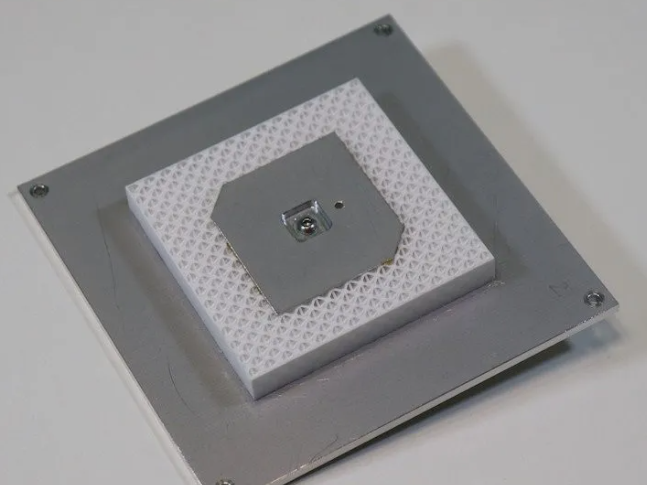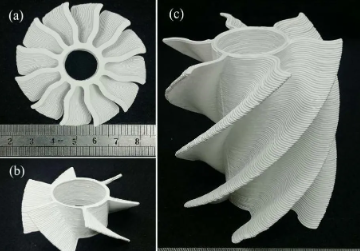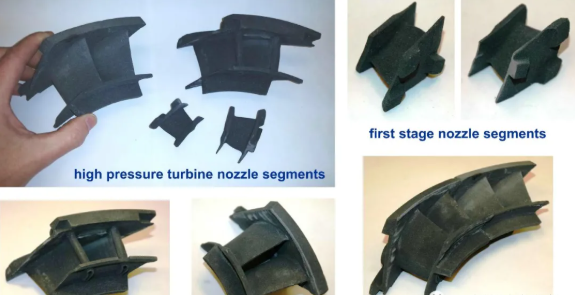3D printing ceramics and appllication in avaition
One of the main interests of ceramic 3D
printing in aerospace field is to use this technology to manufacture ceramic
matrix composites, which have obvious performance advantages over superalloys
and much lower density. For aerospace applications, the focus is on the
development of SiC matrix composite combustion chamber lining, premixed fuel
nozzle shield, turbine guide vane, nozzle and other engine components.
The conventional manufacturing methods of
these components are based on the infiltration of preforms, such as chemical
vapor infiltration, polymer infiltration pyrolysis, melt infiltration and
hybrid methods combining these processes. These methods are usually slow,
involving multiple steps and a lot of post-processing. 3D printing will be
simpler and can achieve free and complex geometry, including sharp changes in
section size, and the manufacture of hybrid and multifunctional composites. In
addition, 3D printing can reduce production steps and shorten production time,
so as to reduce costs. The main challenge lies in the mixing of fiber
reinforced materials, the complete densification of parts and the optimization
of process and properties.
Key features of several mainstream ceramic
3D printing processes
At present, several ceramic 3D printing processes
are exploring the application of military aircraft, such as SLA, DLP, direct
ink write (DIW), Selective Laser Sintering and aerosol jet (AJP).
1.
SLA and DLP have similar principles.
Ceramic powder is added to the resin to obtain ceramic slurry for 3D printing.
Compared with other technologies, the technology based on light curing is
suitable for preparing large parts with high precision and complex shape.
However, the requirements for slurry are generally high. For example, the
slurry needs to have high solid content and low density. At the same time,
ceramic particles need to be evenly dispersed in the resin. Moreover, the
equipment used in this method is expensive and the manufacturing cost is high.
Several international well-known ceramic 3D printing equipment manufacturers
adopt this forming technology.

2.
Direct ink write (DIW) technology is to mix
ceramic powder with various organics to make ceramic ink, and then print it on
the forming plane by printer to form ceramic blank. For inkjet printing
technology, the preparation of ceramic ink is the key. This requires that the
ceramic powder can be well and evenly dispersed in the ink, with appropriate
viscosity, surface tension and conductivity, fast drying rate and as high solid
content as possible. At present, the difficulty of this technology is that the
solid content in the ink is too low, which will lead to the low density of the
ceramic body, and excessive increase of the solid content will make it
difficult to spray the ink. Previously, researchers used this technology to
prepare Si3N4 ceramic gear blank, with density of 3.18 g / cm3, fracture
toughness of 4.4mpa
M1 / 2 and compressive strength of 600MPa. It can be seen
that the products obtained by inkjet printing technology have good mechanical
properties. This also shows that inkjet printing technology has great potential
in the production of high-performance silicon nitride ceramics.
3.
binder jetting is to selectively spray binder on the powder
bed and obtain the final ceramic body through layer-by-layer manufacturing.
This technology has great advantages in preparing porous ceramic parts, but its
forming accuracy is poor and the surface is rough, which is closely related to
powder composition, particle size, fluidity and wettability. In the
manufacturing process, the size and surface accuracy of the obtained blank can
be improved by controlling the humidity of the powder layer. The density of
parts prepared by binder jetting forming method is generally low, and
subsequent processes are usually required to improve its density. For example,
cold isostatic pressing and high-pressure infiltration treatment before
sintering can significantly improve the compactness of sintered products, but
also reduce the productivity. Ti3SiC2 ceramics were prepared by binder jetting
technology, followed by infiltration of silicon melt and aluminum silicon
alloy. The density of the composite can reach 4.1g/cm3. The maximum bending
strength of this fully dense material is 233 MPa and its mechanical properties
are good. binder jetting technology provides a new scheme for the preparation
of ceramic composites.
4.
Selective Laser Sintering (SLS) uses laser to selectively
scan the surface of the powder bed, so that the powder materials are heated,
melted and bonded together, and finally form the green body. The sintering
temperature of ceramic materials is very high, so it is difficult to sinter
directly. At present, ceramic materials can only be sintered by indirect laser
selective sintering method. The method is to cover the surface of ceramic
particles with low melting point organic binder, and then laser only melts the
organic binder to combine the ceramic particles with each other. Although the
improved forming process is relatively simple, due to the high content of
organic polymer binder, the resulting green body density is low, loose and
porous. Therefore, subsequent treatment is usually required to improve the
density, such as isostatic pressing treatment, infiltration technology, etc.
The military aircraft industry is also exploring 3D printing
to improve combat readiness and affordability. Ceramic 3D printing has proved
to be used to produce metal casting cores and molds, which greatly saves time
and cost. In this regard, ceramic 3D printing can be used to mold traditional
parts and manufacture new wings with improved cooling channel designs, which
cannot be manufactured by traditional methods.
Ceramic 3D printing is also regarded as a disruptive
innovative technology used in extreme environments, which can meet the needs of
high-temperature materials (such as ultra-high temperature ceramics) and
complex geometry. However, there is a lack of 3D printing process that can be
produced at low cost and on a large scale to produce high-strength and damage
resistant ceramics. An attractive area of early ceramic additive manufacturing
is the low-cost engine development of small UAV, which can significantly
improve the performance of the engine. In these applications, the higher
component failure risk has a relatively insignificant impact, which can be
regarded as a test platform for prototyping and accelerating iteration.


